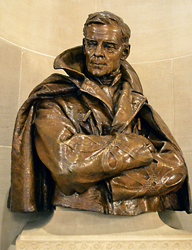Richard Owen was born on January 6, 1810 at Braxfield House, Lanarkshire, Scotland. He was born into a prominent family, being the youngest brother of David Dale and Robert Dale Owen. Richard Owen and his brothers received an ample amount of education, beginning with tuition under a private tutor, later at the Lanark grammar school. Owen then spent three years at Hofwyl, Switzerland, where he participated daily in military drills, became familiar with French and German, and began his studies in chemistry. Later, he took an entire course in chemistry and physics with Dr. Andrew Ure at the Andersonian Institution. Afterwards, Richard and David Dale Owen conducted chemistry experiments together.50
Richard Owen and his brother, David Dale, moved to New Harmony, Indiana in 1827, when Owen was 17 years old. At that time, Owen was a teacher in the area. Richard Owen had the opportunity to travel often, spending some time farming in Lancaster County, Pennsylvania and three years in Cincinnati, learning malting and brewing under his friend Dr. William Price. This experience was very useful to him when he found himself the owner of a large plot of land, including a flour mill.51 Richard Owen married Miss Anne Neef in 1837, and they were to have three children.52
By 1847, Richard Owen’s brother, Robert Dale Owen, was in the U.S. Congress. Robert Dale was able to use his position to get Richard Owen appointed captain in the 16th U.S. infantry. In this position, Owen travelled to Mexico from April 1847 to August 1848. After his return from the Mexican war, Owen joined his brother David Dale in his survey of the Northwest Territory. In this survey, the Owens brothers made observations on the land, representing these observations in reports, illustrative sketches and diagrams. This experience led to Owen being asked to be the chair of Natural Science of the U.S. Military Academy, a position which he held for nine years.53
In his last three years with the U.S. Military Academy, the Academy formed a department with Nashville University. While in Nashville, Owen took courses for two years in order to receive his M.D. in 1858. Following this, Owen returned to New Harmony where he began work on the Indiana Geological Survey. Following the death of his brother, David Dale in 1860, Richard Owen was appointed Indiana State Geologist. Soon after, Richard Owen was asked by Governor Morton to serve as the Lt. Colonel of the 15th Indiana Volunteers (May 1861). Following the battle of Greenbrier, West Virginia, Owen was promoted to be the colonel of the 60th Indiana Volunteers.54
It was in his position as colonel that Richard Owen completed the assignment that he is most well-known for, when he was assigned to guard prisoners of war at Camp Morton in Indianapolis. Following the fall of Fort Donelson, 3,700 prisoners were going to be sent to Camp Morton, and soldiers were needed to guard the prisoners.55 Richard Owen’s 60th Indiana was one of multiple groups brought to the camp, and Richard Owen was put in a leadership position.56 Owen’s stated goal was to treat prisoners in such a way “calculated to make them less restless in their confinement, and likely, when they returned to their homes, to spread among their friends and acquaintances the news that they had been deceived regarding northern men.”57 Up to this time, no rules existed guiding the treatment of prisoners, so Owen took it upon himself to write up a list of rules under which Camp Morton would operate. This list included eleven rules which concerned the structure of the camp, what would be considered crimes and how they would be punished, provisions for the washing of clothes and quarters, and general rules about the life of the average prisoners, including a provision for the creation of a prisoners’ fund.58
Under Owen’s new rules, prisoners were given many freedoms which were not allowed in other camps. Some of these unique freedoms were the ability to purchase and read magazines and books, as well as to assemble in groups.59 As word of Owen’s kindnesses spread, he was criticized for being too lenient. This criticism required Owen to defend his system, which he did by writing a lengthy letter to the Indianapolis Journal, which was published on April 21, 1862.60 Soon after, on May 26, Owen received orders that his regiment was being sent to active duty, which meant a change in leadership at Camp Morton.61 Hearing the news, a group of prisoners at Camp Morton created a petition which they sent to Governor Morton, asking that Colonel Owen and his regiment be allowed to remain at the camp. Regardless of their efforts, Colonel Owen and his regiment were still sent to active duty, leaving Indianapolis for Louisville on June 20, 1862.62
Though Owen was not allowed to stay at Camp Morton, his good reputation was noted on the record and preceded him. Soon after his return to active duty, Owen and his regiment were captured by General Braxton Bragg’s army (September 1862). Because of the kind treatment which he had shown during his time at Camp Morton, Owen’s sidearms were not taken from him and he was treated very well.63
After finishing his service, Richard Owen became a professor at Indiana University, where he worked for 15 years. Throughout this time, Owen participated in a number of surveys, including those of New Mexico, Arizona and North Carolina. He also had the opportunity to travel to Europe, Asia and Africa.64 Owen Hall at Indiana University was named after him. In 1872, Owen was elected President of Purdue University and served until 1874. He then returned to a professorship at Indiana University.
After resigning as professor at Indiana University, Owen returned to New Harmony. It was there that Richard Owen suddenly passed away on March 24, 1890. His death was caused by accidental poisoning, when a jug of embalming fluid was sent by mistake to Owens’s neighbor. The jug, labeled “medicated water,” was mistaken for mineral water, and Owen and a friend drank small quantities. Discovering their mistake, medical aid was sought, but it was too late for Richard Owen.65
Bust History
In 1911, Archibald Cunningham, the editor of Confederate Veteran Magazine, received permission to place a bronze memorial tablet in honor of Colonel Richard Owen’s service as commandant of Camp Morton in Indianapolis. Contributions were solicited, and they were so great that there were sufficient funds to commission a bronze bust instead. This bust was placed in the Indiana Statehouse, and now sits in a niche in the southeast corner outside of the rotunda. The dedication took place in 1913, celebrated with a ceremony attended by veterans from both the north and south. A replica of the bust was placed in the Indiana Memorial Union on the Indiana University campus in Bloomington.
Sculptor
Belle Kinney
Regarding the Owen bust, Kinney Scholz said, "It was my aim to portray such a man as he might look while pondering over the meaning of the great struggle in which he was then taking part - his sympathetic heart touched by the suffering it caused, yet realizing its necessity…no work I have ever done gave me as much pleasure as the Owen bust."67
50 Winchell, N.H. “A Sketch of Richard Owen.” The American Geologist 6, no. 3 (September, 1890). p. 135-136.
51 Ibid. p. 136.
52 Ibid. p. 139.
53 Ibid.
54 Ibid. p. 137.
55Winslow, Hattie Lou and Moore, Joseph R. (1995) "Camp Morton, 1861-1865, Indianapolis, IN." Indiana Historical Society Press (Indianapolis). p. 253.
56 Ibid. p. 261-262.
57 Ibid. p. 262.
58 Ibid. p. 263-265.
59 Ibid. p. 272.
60 Ibid. p. 275. Text of the letter is available in the following printed sources. 61 Ibid. p. 282-283.
62 Ibid. p. 283-284.
63 Ibid. p. 284.
64 Winchell, N.H. p. 138.
65 Ibid. p. 135.
66 Beckman, Tim. “Camp Morton - Civil War Camp and Union Prison, 1861-1865, Indianapolis, Indiana.” http://freepages.history.rootsweb.ancestry.com/~indiana42nd/campmorton.htm Elise L. Smith, "Belle Kinney and the Confederate Women's Monument," The Southern Quarterly 32 (1994).

